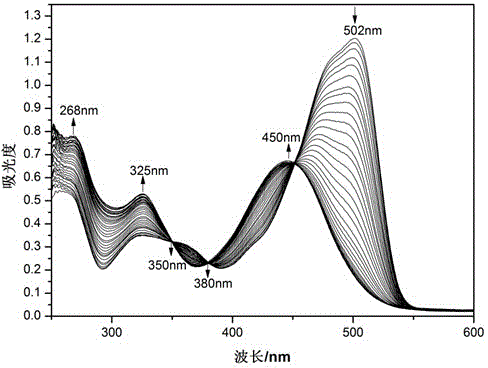Two-sided Schiff base sensor, synthesis method thereof, and application thereof in fluorescent colorimetric continuous identification of Cu<2+> and H<2>PO<4><->
A H2PO4-, Schiff base technology, applied in fluorescence/phosphorescence, analysis by chemical reaction of materials, material analysis by observing the impact on chemical indicators, etc., can solve the problem of expensive sensors, long response time, complex Operation, etc.
- Summary
- Abstract
- Description
- Claims
- Application Information
AI Technical Summary
Problems solved by technology
Method used
Image
Examples
Embodiment Construction
[0038] Below by specific embodiment sensor molecule of the present invention M and synthesis as well as continuous detection of Cu in 2+ and H 2 PO 4 - application is further explained.
[0039] 1. Sensor molecules M Synthesis of DMF: Add 0.49g of 3,3′-dimethoxybenzidine, 0.78g of 2-hydroxy-1-naphthaldehyde, 10mL of glacial acetic acid and 30mL of DMF into a round bottom flask, stir and dissolve, and react at 85°C for 8 hours . After the reaction, cool down to room temperature, and a red precipitate precipitates out after a while, filter it with suction and wash it three times with hot absolute ethanol, and finally recrystallize it with DMF to obtain a red powdery sensor compound M (0.51 g, 85% yield). Its structure and synthetic formula are as follows:
[0040]
[0041] compound M structure through the following IR,1 H NMR, and single crystal X-ray diffraction data prove:
[0042] m.p. >300℃. IR: (KBr, cm -1 ) n: 3435 (OH), 3064 (Ar-H), 2928 (CH 3 ), 2830 (CH ...
PUM
 Login to View More
Login to View More Abstract
Description
Claims
Application Information
 Login to View More
Login to View More - R&D
- Intellectual Property
- Life Sciences
- Materials
- Tech Scout
- Unparalleled Data Quality
- Higher Quality Content
- 60% Fewer Hallucinations
Browse by: Latest US Patents, China's latest patents, Technical Efficacy Thesaurus, Application Domain, Technology Topic, Popular Technical Reports.
© 2025 PatSnap. All rights reserved.Legal|Privacy policy|Modern Slavery Act Transparency Statement|Sitemap|About US| Contact US: help@patsnap.com



